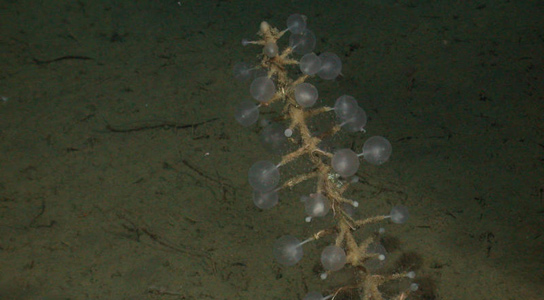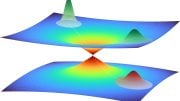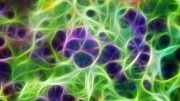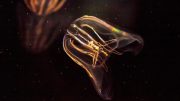
Chondrocladia sp. Credit: Photo courtesy of MBARI and Craig McClain
The Monterey Bay Aquarium Research Institute (MBARI) has unveiled footage of a new species of carnivorous sea sponge. Chondrocladia lyra was discovered using deep-diving vessels by a team of researchers off the coast of California, at depths of 3,316 to 3,399 m.
The scientists published their findings in the journal Invertebrate Biology. 17 years ago, researchers at the Center of Oceanology at France’s Aix-Marseille University provided the first evidence of a species of deep-sea sponge living in a Mediterranean cave, at a shallow depth. It snared prey, like small fish and crustaceans, instead of absorbing bacteria and organic particles through their bodies, as most other sea sponges do.
This sponge was part of the Asbestopluma genus, and belonged to the Cladorhizidae family of carnivorous demosponges, a class that contains over 90% of the world’s sponges. Since then, circa 1995, 24 new species of cladorhizid sponges have been discovered. It has been difficult to study their behavior since their natural habitat is situated at such incredible depths.
In this video we describe a new species of carnivorous sponge, Chondrocladia lyra from the deep-sea off California. C. lyra is called the harp sponge because its basic structure, called a vane, is shaped like a harp or lyre. Each vane consists of a horizontal branch supporting several parallel, vertical branches.
MBARI has two ROVs and they’ve used these to study C. lyra. C. lyra can catch prey, envelop it in membrane and digest it whole. The vertical branches and horizontal stolons that make up the sponge are covered in barbed hooks and spines. A number of crustacean prey were passively ensnared onto these branches. Then, they were aggressively enclosed in a cavity to be dismembered into small, digestible particles.
C. lyra grow up to 37 cm (14.5 inches) in length, and are anchored to the sea floor by a rhizoid, which resembles a root system. They can have 1 to 6 vanes, each supporting a number of equidistant vertical branches. The terminal balls produce spermatophores, which are released into the area in order to fertilize other harp sponges in the area. C. lyra also has an egg development area around the mid-point of the branches. Once the spermatophores make contact with it, these areas swell up as the eggs are fertilized and begin to mature.
Reference: “An extraordinary new carnivorous sponge, Chondrocladia lyra, in the new subgenus Symmetrocladia (Demospongiae, Cladorhizidae), from off of northern California, USA” by Welton L. Lee, Henry M. Reiswig, William C. Austin and Lonny Lundsten, 18 October 2012, Invertebrate Biology.
DOI: 10.1111/ivb.12001









Be the first to comment on "Carnivorous Deep Sea Sponge Discovered Off Coast of California"